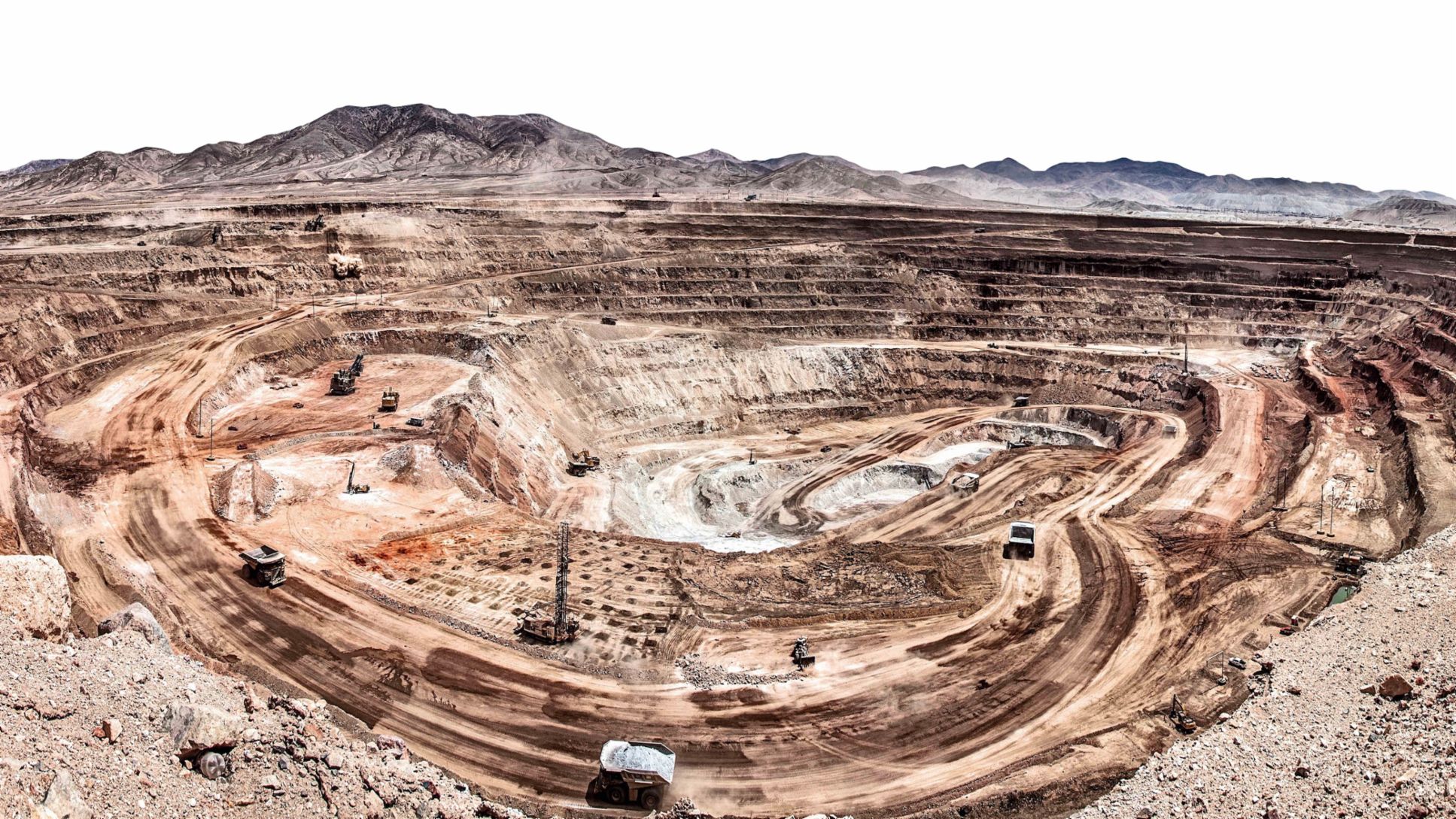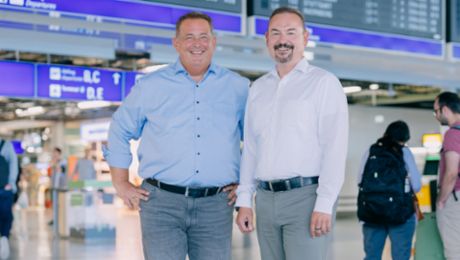Death Valley seems almost pleasant in comparison to the Atacama Desert, located in the Antofagasta Region of Chile—the driest place in the world, where rain might not fall for decades and temperatures can swing between 86 degrees Fahrenheit by day and 5° F at night. This is also a land of massive, gaping craters—and one of them is the site of the Gabriela Mistral copper mine.
You won’t find a driver in the 30-ton Komatsu trucks at this mine. The yellow vehicles in the 930E4 AT model series are guided by intelligent software through the 1.8 square miles of the 950-foot pit. Day after day, they haul 210,000 metric tons of copper ore-bearing rock. Thanks to its fleet of 17 self-driving trucks, this Codelco mine that opened in 2008 is one of the most modern of its type in the world. It also uses robots to inspect the drilling and loading equipment before scheduled maintenance in order to determine the actual need for repairs, which gives employees more time to focus on important high-value activities.
At Ministro Hales employees use remote control for all major operations
Other Codelco mines have similarly modern processes. At the Ministro Hales site near the city of Calama, which opened in 2010, employees use remote control for all major operations. At the El Teniente copper mine around 932 miles to the south, artificial intelligence helps the powerful LHDs (load, haul, and dump machines) perform semi-autonomous underground operations that otherwise would need to be run by people. The company is already testing fully automated operations that would only require employee intervention if problems arose. “Automation and the incorporation of semi-autonomous and autonomous equipment will not only improve our productivity but also the sustainability of our highly complex operations as well as the safety of the people working in this risky field,” says José Robles, Vice President Supply Chain at Codelco.
Codelco’s broad range of cutting-edge technologies is part of an ambitious strategy by the world’s largest copper producer to make a traditional industry fit for the future by means of comprehensive digitalization. Headquartered in the capital city of Santiago de Chile, the company was founded in 1976 when several nationalized copper mines were merged; its name is derived from “Corporación Nacional del Cobre de Chile.” Codelco developed an eight pronged corporate agenda for its productivity transformation, with Porsche Consulting involved in both the development and implementation.
Codelco seeks to save more than $500 million by 2020
Codelco began modernizing its supply chain management in 2016, which, according to Ingo Glawe, Partner for Porsche Consulting in South America and responsible for the project, is also the most advanced part of the agenda. “We used to believe that we had a supply chain organization, but now we really do,” says Robles. “We now have a strategic approach that comprises the purchase of supplies by categories. That allows us to improve the costs siginificantly.”
By converting its procurement, logistics, and storage operations, the Chilean copper producer seeks to save more than $500 million by 2020—money that needs to be invested in new technologies.
The company is responding to fundamental changes facing the entire sector. In order to access increasingly scarce resources, mines need to reach greater depths and become technically more sophisticated. El Teniente, for example, has been producing copper for hundreds of years. With more than 1,864 miles of underground tunnels, it is now the largest copper mining operation of its kind in the world. “The worldwide copper industry has had only a few major technological leaps,” says Robles. “The chemical process of flotation was introduced around 60 years ago. Thirty years later the extraction by solvents led to a structural change because it made the extraction of copper economical even in sites with less concentration. We have now reached a point when when innovation will allow us to become more economical again.”
Mining companies test and invest in new technologies
In order to achieve higher levels of performance, mining companies have begun to test and invest in new technologies. Codelco is no exception: in 2016, it founded a subsidiary by the name of Codelco Tech, an agile innovation lab whose employees work exclusively on transformation projects. Codelco Tech seeks to work together with suppliers, research institutes, and start-ups to develop open solutions that benefit the entire industry. In addition to autonomous LHDs and robot diagnostics, these include an integrated processing center at company headquarters that gathers and analyzes historical data from different mines in order to optimize processes and support decisions.
Technical innovations are needed to counteract the declines in productivity and ore content that are plaguing the field. According to experts, the copper content in the rock mined worldwide today is just over half the level in 1990. Operators like Codelco therefore have to contend with rising costs per metric ton of material at a time when prices for minerals like copper are undergoing enormous fluctuations on world markets. Copper lost a third of its value in 2015, for example, before starting to recover in early 2016.
Investments in modern equipment and processes are needed because demand for minerals will continue to rise while known reserves of many raw materials might be depleted as early as the end of this century. As a malleable conductor of heat and electricity, copper is especially valuable. It is used to make items like cables, electric motors, and electronic circuits, and also for antimicrobial coatings. Experts expect demand for this metal to exceed worldwide production already by 2030. And governments, regulatory bodies, and municipalities are placing higher requirements on mining operations in terms of safety and sustainability for both people and the environment.
Digitalization can generate potential
“The problems facing mining around the world are well known. They are driven by a rise in operational costs and a decline in production levels. Increased productivity will therefore become a crucial competitive advantage,” says Glawe. “The answers to all of these challenges lie in digitalization and automation, which means integrating data flow and optimizing processes in real time.”
Digitalization can generate potential, especially in the fields of robotics, material technologies, artificial intelligence, machine learning, progressive factories, and 3-D printing. According to estimates from the World Economic Forum, digitalization could help the mining industry save around $190 billion over the next decade, which amounts to nearly 3 percent of total industry sales.
The areas where digital technologies can be applied include optimizing supply chains by means of greater networking among suppliers and customers, digital procurement processes to ensure transparency in prices and costs, and more sustainable use of resources like water and electricity. Mineral exploration and production can also be performed more efficiently and economically with the help of drone technology and precision geological data, which can produce high-resolution maps of resource deposits and deploy big data to monitor optimum recovery.
Leading mining companies like Codelco have therefore added an entire collection of new technologies to their strategic planning. In addition to autonomous vehicles above and below ground and their predictive maintenance, these include portable technologies like sensors, augmented reality, and virtual reality (AR/VR), which increase the efficiency and safety of employee training and activities. Intelligent helmets at some sites can already measure miner fatigue and give automatic warnings if needed. The data gathered in routine operations help engineers both improve their designs of roads, ramps, and shafts, and mark them to achieve the highest possible levels of safety and efficiency.




